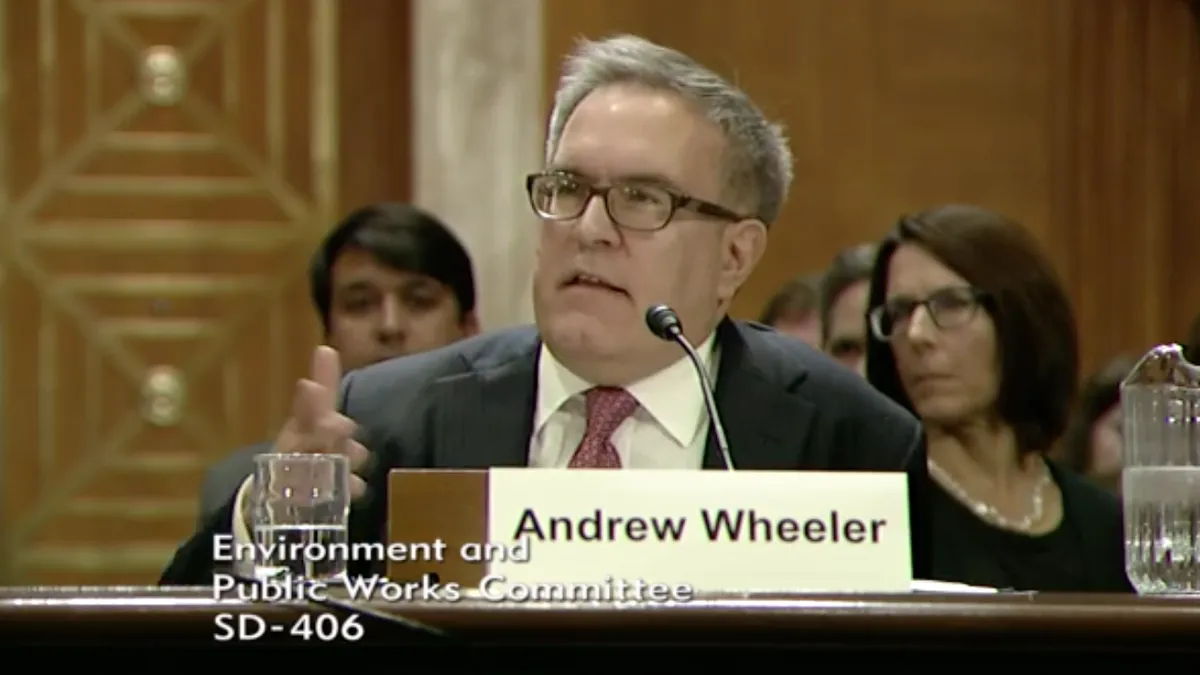Dive Brief:
-
The Environmental Protection Agency on Thursday moved to rescind pollution limits on new coal plants set by the Obama administration that require generators to install costly carbon capture technology.
-
EPA's current New Source Performance Standards (NSPS) for coal plants require that new generators emit no more than 1,400 pounds of carbon dioxide per megawatt-hour of power, but Administrator Andrew Wheeler announced his agency will raise that limit to 1,900 pounds for large generators.
-
Utilities, analysts and EPA's own analysis of the NSPS rollback say that new U.S. coal plants are unlikely due to competition from cheaper resources, despite the loosening of multiple environmental regulations.
Dive Insight:
While it is unlikely to halt the decline of coal power, EPA's decision to lift emissions caps for new generators marks the latest action from the Trump administration to spark a comeback for the resource.
The EPA has already moved to rescind Obama-era rules on carbon and mercury emissions from existing and modified generators, as well as regulations on coal ash, a toxic byproduct of burning coal.
Alongside those efforts, the Department of Energy has boosted research into coal technologies, including a new initiative for small, modular coal plants.
Rolling back the Obama administration's New Source rules would remove another regulatory hurdle for new generators. The standards, finalized in 2015, set emissions limits for large coal generators at a level that could not be achieved without carbon capture and storage (CCS) technology.
Those limits were a frequent point of contention for coal generators and conservative states, who argued in a legal challenge that CCS technologies are costly and not commercially available. Wheeler echoed that talking point in a Thursday event at EPA headquarters in Washington.
"Their interpretation was disingenuous," Wheeler said of the Obama administration. "They knew [CCS] technology was not adequately demonstrated."
In place of Obama-era standards, Wheeler pledged to promulgate "high but achievable standards that are rooted in reality." New emissions limits will be 1,900 pounds per megawatt-hour for large generators and 2,000 pounds for smaller plants, while coal refuse-fired units will have a 2,200 pound limit.
Even with the regulatory rollbacks, utilities are not expected to invest in new coal generation. In August, after the EPA moved to rescind the Obama-era Clean Power Plan, Southern Co. CEO Tom Fanning told Utility Dive he still did not expect to invest in new coal plants or upgrades for his existing units because of competition from cheaper resources.
"The forward curve for natural gas looks exceedingly attractive," he said.
Instead of adding new coal, utilities are retiring plants at an accelerated pace. S&P expects coal retirements in 2018 to be the second highest on record as utilities increasingly find that lower cost renewables and natural gas are undercutting their existing generators.
Xcel Energy added to that trend this week, committing to eliminate carbon emissions from its power generation by 2050 as it moves to replace coal with wind and solar resources across its eight-state service area. That followed an announcement from the Northern Indiana Public Service Co. that it could save customers $4 billion by retiring its coal fleet years early and replacing them largely with renewables.
EPA's own economic analysis on the NSPS rollback aligns with those trends, saying that new coal generators are unlikely.
"[E]ven under the emissions limits included in this proposal, new fossil fuel-fired capacity constructed through 2026 and the years following is expected to be natural gas capacity," it reads.
Wheeler, however, told reporters Thursday he does not know if U.S. utilities will add new coal plants.
"Whether or not new coal plants will be built in this country is a decision the utility industry will make," Wheeler said. "We're not trying to pick winners and losers."
Even if new plants are not built, Wheeler hopes looser pollution regulations could lead to the development of new, non-CCS technologies that can be used in plants overseas. The potential to deploy the technologies domestically could spur more research and development for export, he said.
"I'd love to see all the coal plants built in China and India to meet our standards," he said.













